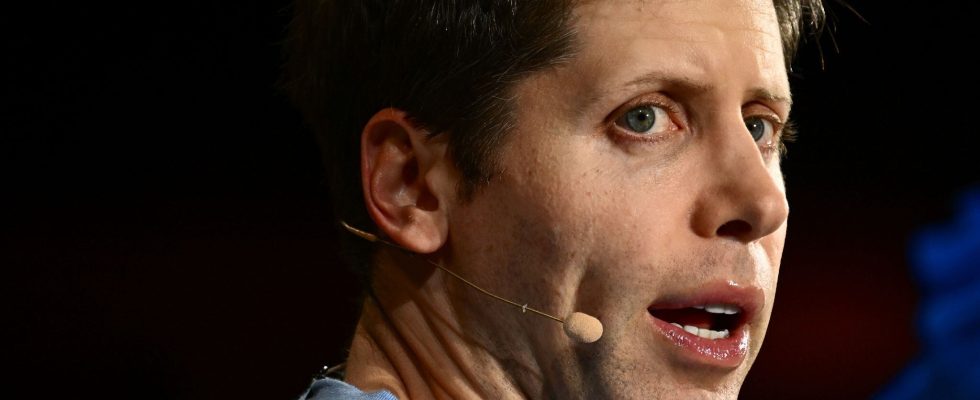A weekend to make Netflix screenwriters swoon. Friday, to everyone’s surprise, the board of directors of OpenAI announced the dismissal of its boss Sam Altman without elaborating on the details except his lack of frankness “in his communications with the board, hindering its ability to fulfill its responsibilities”, and that the body therefore no longer had “confidence in its ability to direct OpenAI”…
After two days of tumult within the group, shocked by the speed and lack of transparency of this drastic change, several American media relayed that some of the investors, primarily Microsoft, were working to bring Sam Altman back at the head of the organization. The AI genius himself confirmed that negotiations were taking place within the OpenAI premises, smiling about the fact that this was the “first and last time” that he had worn a “visitor” badge at the within the organization that he himself co-founded in 2015.
Before what seems to be the conclusion of this ultimately expeditious series. This Monday, November 20, Microsoft, which has nevertheless invested more than 10 billion dollars in OpenAI, announced that the AI prodigy would now set up shop in its premises, at the head of a “new research team” . There he will notably find Greg Brockman, also co-founder of OpenAI, who had chosen to leave the organization in support of Altman.
Altman at the center of the game
So what was going through OpenAI’s mind to part ways with one of the most influential emerging figures in artificial intelligence? For the British weekly The Economist (liberal), The upheaval is the latest episode in the ongoing conflict between two warring camps in the industry, which they categorize as the “doomers” and the “boomers.” The former fear that “if left unchecked, AI represents an existential risk for humanity, and therefore advocate stricter regulations”. The latter, for their part, “minimize fears of an IT apocalypse and emphasize its capacity to stimulate progress.”
Sam Altman, for his part, seemed to swim skillfully between the two camps, capable of warning of the dangers that AI can represent, as last May when interviewed by the American Congress, he called for greater regulation of the sector. “One of my greatest fears is that we, this industry, this technology, will cause significant damage to society,” he worried at the time before American senators. But on the other hand, it also seemed to push OpenAI to continue to develop the group’s AI ever more quickly.
A complex model
This is indeed the course to follow for OpenAI which seems to have marked its split with Sam Altman. With the tensions at the heart of the complex question of the group’s model. Since its creation in 2015, the OpenAI entity has been a non-profit organization, claiming to develop ethical and positive artificial intelligence for humanity. But as recalled CNNin 2019, Altman and others created OpenAI LP, “a for-profit entity that exists within the corporate structure. This for-profit company took OpenAI from zero value to a valuation of $90 billion in just a few years – and Sam Altman is widely credited as the mastermind behind this plan and the key to the company’s success.”
A for-profit business means a need to develop its activities more and more quickly and increase profits. And according to the New York Times (center-left), it is this last aspect which would have pushed Ilya Sutskever, chief scientist at OpenAI and member of the board of directors, to opt for the dismissal of Sam Altman, fearing that he “would not concentrate too much on the development of OpenAI’s activities and does not pay enough attention to the dangers of AI.”
A concern which seems to be confirmed by the choice of the group’s new interim leader, Emmett Shear. Co-founder of Twitch, which he left last March, the latter never hid his fears as for an overdeveloped artificial intelligence capable of learning on its own.
For OpenAI, a badly damaged reputation
The fact remains that the way in which OpenAI operated could well have seriously damaged the reputation of a company for which everything seemed to be smiling since the launch of ChatGPT in November 2022. American media The Information reported this Sunday that a dozen OpenAI employees had already left the organization in support of Sam Altman, including Mira Murati, the group’s emblematic technical director, considered one of the most important creators of ChatGPT.
They also all published on X (formerly Twitter) the same message this Monday: “OpenAI is nothing without its people”, testifying to the open conflict against the management of their former organization.
By rushing to hire Sam Altman, Greg Brockman and surely other OpenAI thinking heads, Microsoft seems to be saving the furniture from a very expensive operation in the media and which could even have caused its stock market value to plunge. But in an ultra-competitive sector, the tech giant could also have recovered one of the rising figures for the coming years.
